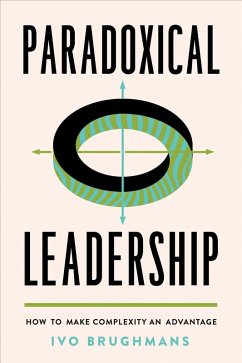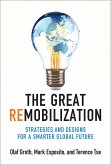- Gebundenes Buch
- Merkliste
- Auf die Merkliste
- Bewerten Bewerten
- Teilen
- Produkt teilen
- Produkterinnerung
- Produkterinnerung
Paradoxical Leadership reveals how to use tensions between seemingly contradictory perspectives as a driver for sustainable success and innovation.
Andere Kunden interessierten sich auch für
![The Digital Multinational The Digital Multinational]() Satish NambisanThe Digital Multinational22,99 €
Satish NambisanThe Digital Multinational22,99 €![The Great Remobilization The Great Remobilization]() Olaf GrothThe Great Remobilization35,99 €
Olaf GrothThe Great Remobilization35,99 €![In the Kingdom of Shoes In the Kingdom of Shoes]() Zachary Austin DoleshalIn the Kingdom of Shoes41,99 €
Zachary Austin DoleshalIn the Kingdom of Shoes41,99 €![Searching for Trust in the Global Economy Searching for Trust in the Global Economy]() Jeanne M. BrettSearching for Trust in the Global Economy30,99 €
Jeanne M. BrettSearching for Trust in the Global Economy30,99 €![The Digital Silk Road The Digital Silk Road]() Jonathan E. HillmanThe Digital Silk Road26,99 €
Jonathan E. HillmanThe Digital Silk Road26,99 €![The Digital Silk Road The Digital Silk Road]() Jonathan E. HillmanThe Digital Silk Road38,99 €
Jonathan E. HillmanThe Digital Silk Road38,99 €![Beyond Great Beyond Great]() Arindam BhattacharyaBeyond Great21,99 €
Arindam BhattacharyaBeyond Great21,99 €-
-
-
Paradoxical Leadership reveals how to use tensions between seemingly contradictory perspectives as a driver for sustainable success and innovation.
Produktdetails
- Produktdetails
- Verlag: University of Toronto Press
- Seitenzahl: 328
- Erscheinungstermin: 25. April 2023
- Englisch
- Abmessung: 233mm x 156mm x 29mm
- Gewicht: 586g
- ISBN-13: 9781487507633
- ISBN-10: 1487507631
- Artikelnr.: 66281622
- Herstellerkennzeichnung
- Libri GmbH
- Europaallee 1
- 36244 Bad Hersfeld
- gpsr@libri.de
- Verlag: University of Toronto Press
- Seitenzahl: 328
- Erscheinungstermin: 25. April 2023
- Englisch
- Abmessung: 233mm x 156mm x 29mm
- Gewicht: 586g
- ISBN-13: 9781487507633
- ISBN-10: 1487507631
- Artikelnr.: 66281622
- Herstellerkennzeichnung
- Libri GmbH
- Europaallee 1
- 36244 Bad Hersfeld
- gpsr@libri.de
By Ivo Brughmans
Introduction
Part I: In the Lab
1. Polarities and Paradoxes: What Are They and How Do They Work?
1.2 Polarities as the Lifeblood of Adaptive Systems
1.2 How to Engage with Polarities
1.3 How Polarities Work in Organizations and Social Systems
2. The Limitations of Either/Or Thinking
2.1 Various Forms of Either/Or Thinking
2.2 Why Is Either/Or Thinking So Attractive?
2.3 Why Doesn’t the Either/Or Approach Work?
2.4 The Challenge
3. Thinking from a Both/And Perspective
3.1. Why Is a Paradigm Shift Necessary and Inevitable?
3.2 Paradoxical Leadership and Both/And Thinking on the Rise
3.3 The Fundamentals of Both/And Thinking
3.4 Principles of Practice
4. How to Balance between Opposite Poles?
4.1 Coping with Our Own Polarities
4.2 Working with the Polarities of Our Organization
Part II: At Work
5. Setting the Strategic Direction and Steering the Business
5.1 Staying on Course and Strategic Agility
5.2 Specializing and Working Together in One Value Chain
5.3 Giving Direction to an Organization without Putting It in a
Straitjacket
5.4 The Obsession to Measure Everything and the Limitations of Kips
6. Change
6.1 Change and Continuity: The Old and the New
6.2 Adaptability, Versatility, and Identity
6.3 Polarization and Tribal Wars
6.4 Paradoxical Interventions: Doing the Opposite to What We Want to
Achieve
7. Where People and the Organization Come Together
7.1 The Power of What Is Hidden in the Shadows
7.2 How Diversity Can Help Us Achieve Better Results
7.3 Creativity and Innovation: A Winding Road
8. Conducting the Paradoxical Dialogue
8.1 The Inner Compass
8.2 How to Shape the Paradoxical Dialogue in Your Team and Organization
8.3 Caught in the Middle: Reconciling Different Worlds
9. Paradoxically Competent
9.1 The Paradoxically Competent Professional and Manager
9.2 The Paradoxical Skill Set
Where Do We Go from Here? Back to the Basics
Appendix: List of Common Polarities
Index
Part I: In the Lab
1. Polarities and Paradoxes: What Are They and How Do They Work?
1.2 Polarities as the Lifeblood of Adaptive Systems
1.2 How to Engage with Polarities
1.3 How Polarities Work in Organizations and Social Systems
2. The Limitations of Either/Or Thinking
2.1 Various Forms of Either/Or Thinking
2.2 Why Is Either/Or Thinking So Attractive?
2.3 Why Doesn’t the Either/Or Approach Work?
2.4 The Challenge
3. Thinking from a Both/And Perspective
3.1. Why Is a Paradigm Shift Necessary and Inevitable?
3.2 Paradoxical Leadership and Both/And Thinking on the Rise
3.3 The Fundamentals of Both/And Thinking
3.4 Principles of Practice
4. How to Balance between Opposite Poles?
4.1 Coping with Our Own Polarities
4.2 Working with the Polarities of Our Organization
Part II: At Work
5. Setting the Strategic Direction and Steering the Business
5.1 Staying on Course and Strategic Agility
5.2 Specializing and Working Together in One Value Chain
5.3 Giving Direction to an Organization without Putting It in a
Straitjacket
5.4 The Obsession to Measure Everything and the Limitations of Kips
6. Change
6.1 Change and Continuity: The Old and the New
6.2 Adaptability, Versatility, and Identity
6.3 Polarization and Tribal Wars
6.4 Paradoxical Interventions: Doing the Opposite to What We Want to
Achieve
7. Where People and the Organization Come Together
7.1 The Power of What Is Hidden in the Shadows
7.2 How Diversity Can Help Us Achieve Better Results
7.3 Creativity and Innovation: A Winding Road
8. Conducting the Paradoxical Dialogue
8.1 The Inner Compass
8.2 How to Shape the Paradoxical Dialogue in Your Team and Organization
8.3 Caught in the Middle: Reconciling Different Worlds
9. Paradoxically Competent
9.1 The Paradoxically Competent Professional and Manager
9.2 The Paradoxical Skill Set
Where Do We Go from Here? Back to the Basics
Appendix: List of Common Polarities
Index
Introduction
Part I: In the Lab
1. Polarities and Paradoxes: What Are They and How Do They Work?
1.2 Polarities as the Lifeblood of Adaptive Systems
1.2 How to Engage with Polarities
1.3 How Polarities Work in Organizations and Social Systems
2. The Limitations of Either/Or Thinking
2.1 Various Forms of Either/Or Thinking
2.2 Why Is Either/Or Thinking So Attractive?
2.3 Why Doesn’t the Either/Or Approach Work?
2.4 The Challenge
3. Thinking from a Both/And Perspective
3.1. Why Is a Paradigm Shift Necessary and Inevitable?
3.2 Paradoxical Leadership and Both/And Thinking on the Rise
3.3 The Fundamentals of Both/And Thinking
3.4 Principles of Practice
4. How to Balance between Opposite Poles?
4.1 Coping with Our Own Polarities
4.2 Working with the Polarities of Our Organization
Part II: At Work
5. Setting the Strategic Direction and Steering the Business
5.1 Staying on Course and Strategic Agility
5.2 Specializing and Working Together in One Value Chain
5.3 Giving Direction to an Organization without Putting It in a
Straitjacket
5.4 The Obsession to Measure Everything and the Limitations of Kips
6. Change
6.1 Change and Continuity: The Old and the New
6.2 Adaptability, Versatility, and Identity
6.3 Polarization and Tribal Wars
6.4 Paradoxical Interventions: Doing the Opposite to What We Want to
Achieve
7. Where People and the Organization Come Together
7.1 The Power of What Is Hidden in the Shadows
7.2 How Diversity Can Help Us Achieve Better Results
7.3 Creativity and Innovation: A Winding Road
8. Conducting the Paradoxical Dialogue
8.1 The Inner Compass
8.2 How to Shape the Paradoxical Dialogue in Your Team and Organization
8.3 Caught in the Middle: Reconciling Different Worlds
9. Paradoxically Competent
9.1 The Paradoxically Competent Professional and Manager
9.2 The Paradoxical Skill Set
Where Do We Go from Here? Back to the Basics
Appendix: List of Common Polarities
Index
Part I: In the Lab
1. Polarities and Paradoxes: What Are They and How Do They Work?
1.2 Polarities as the Lifeblood of Adaptive Systems
1.2 How to Engage with Polarities
1.3 How Polarities Work in Organizations and Social Systems
2. The Limitations of Either/Or Thinking
2.1 Various Forms of Either/Or Thinking
2.2 Why Is Either/Or Thinking So Attractive?
2.3 Why Doesn’t the Either/Or Approach Work?
2.4 The Challenge
3. Thinking from a Both/And Perspective
3.1. Why Is a Paradigm Shift Necessary and Inevitable?
3.2 Paradoxical Leadership and Both/And Thinking on the Rise
3.3 The Fundamentals of Both/And Thinking
3.4 Principles of Practice
4. How to Balance between Opposite Poles?
4.1 Coping with Our Own Polarities
4.2 Working with the Polarities of Our Organization
Part II: At Work
5. Setting the Strategic Direction and Steering the Business
5.1 Staying on Course and Strategic Agility
5.2 Specializing and Working Together in One Value Chain
5.3 Giving Direction to an Organization without Putting It in a
Straitjacket
5.4 The Obsession to Measure Everything and the Limitations of Kips
6. Change
6.1 Change and Continuity: The Old and the New
6.2 Adaptability, Versatility, and Identity
6.3 Polarization and Tribal Wars
6.4 Paradoxical Interventions: Doing the Opposite to What We Want to
Achieve
7. Where People and the Organization Come Together
7.1 The Power of What Is Hidden in the Shadows
7.2 How Diversity Can Help Us Achieve Better Results
7.3 Creativity and Innovation: A Winding Road
8. Conducting the Paradoxical Dialogue
8.1 The Inner Compass
8.2 How to Shape the Paradoxical Dialogue in Your Team and Organization
8.3 Caught in the Middle: Reconciling Different Worlds
9. Paradoxically Competent
9.1 The Paradoxically Competent Professional and Manager
9.2 The Paradoxical Skill Set
Where Do We Go from Here? Back to the Basics
Appendix: List of Common Polarities
Index








